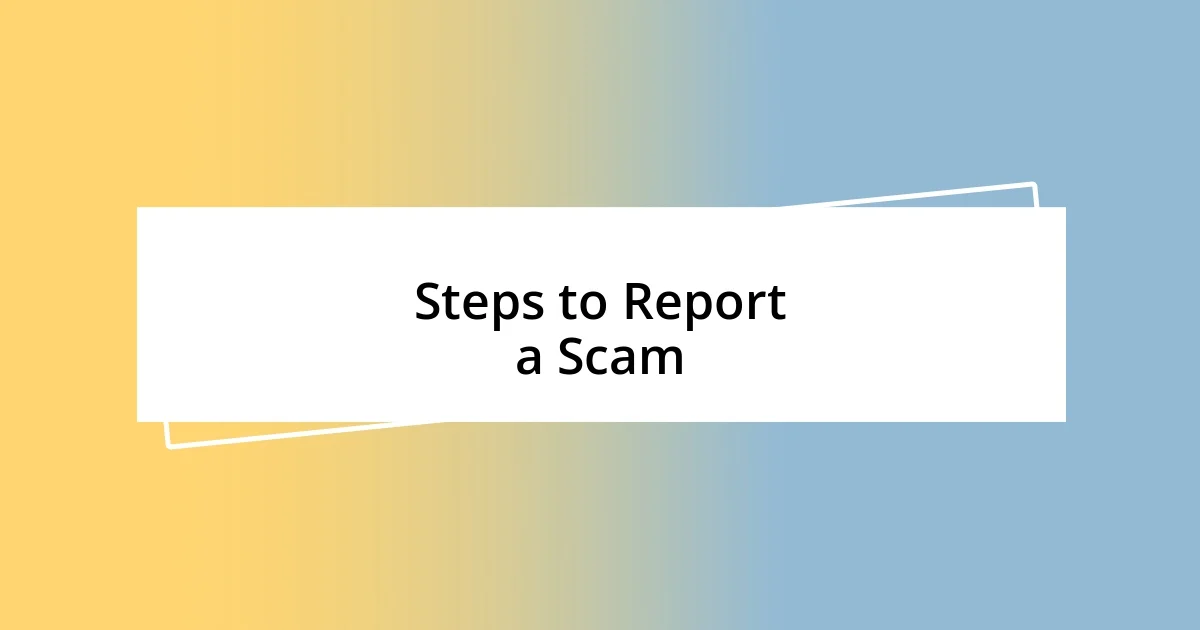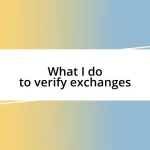Key takeaways:
- Understanding different types of crypto scams, such as phishing, Ponzi schemes, and rug pulls, is essential for protection against fraud.
- Recognizing red flags, including unsolicited contact, pressure tactics, and vague project details, can help you avoid falling victim to scams.
- Continual education, implementing two-factor authentication, and engaging with a community of crypto enthusiasts are key strategies for safeguarding against fraud.

Understanding Crypto Scams
Understanding crypto scams is essential in today’s digital landscape. I remember when a friend of mine excitedly shared a new investment opportunity in a crypto project that seemed too good to be true. The offer promised high returns with little risk—a classic red flag. It turns out the project was a scam designed to siphon funds from unsuspecting investors.
These scams often prey on our emotions, luring us in with the fear of missing out (FOMO) or the allure of easy money. Have you ever felt that rush of excitement when you think you’ve discovered the next big thing? I know I have, and it’s exactly this thrill that scammers exploit. They create convincing narratives that resonate with our hopes and dreams, making it crucial to remain skeptical and vigilant.
Moreover, understanding the different types of crypto scams—like phishing attacks or Ponzi schemes—is vital. I once received a phishing email that appeared genuine, urging me to “verify” my account. It’s unsettling to think how quickly one can be drawn into such traps without knowing the signs. By educating ourselves about these tactics, we empower ourselves to protect our investments and avoid becoming another statistic.

Common Types of Crypto Scams
I’ve encountered many different types of crypto scams, and each one reveals unique tactics to deceive and manipulate. For example, I remember scrolling through social media and stumbling upon an ad promoting a “guaranteed” investment in a new coin. It wasn’t long before I realized this was a pump-and-dump scheme, where the promoters sell off their holdings at a profit just after luring in unsuspecting investors. These schemes thrive on hype, creating artificial demand to inflate prices and then leaving victims in the dust.
Here are some common types of crypto scams to watch out for:
- Phishing Scams: Fraudsters send emails or messages posing as legitimate sources, asking for sensitive information.
- Ponzi Schemes: New investors’ money is used to pay earlier investors, creating an illusion of profitability until it collapses.
- Fake Exchanges: Websites that mimic real trading platforms, tricking users into depositing funds that disappear.
- Investment Scams: Promises of high returns from novel projects, often without any real backing or transparent information.
- Rug Pulls: Developers abandon a project after drawing in investors, taking their funds with them.
I once got an email that seemed to come from a well-known exchange, updating me about a new security feature. The excitement of potentially upgrading my security soon turned into paranoia when I realized it was a ploy to get my login details. I felt a sense of vulnerability, a stark reminder that I had to be more cautious and aware. This experience reinforced the idea that being informed about these scams is essential in navigating the often treacherous waters of crypto investing.

Recognizing Red Flags in Scams
Recognizing red flags in scams is crucial, especially in the fast-paced world of cryptocurrency. One common warning sign is unsolicited contact. When I once received a direct message from someone claiming to represent a popular crypto brand, I felt a rush of excitement initially. But when they asked for my private keys to ensure my account’s security, I quickly realized it was a scam. This experience taught me that if a stranger reaches out with something that sounds too good to be true, it often is.
Another red flag is the use of pressure tactics. Scammers thrive on urgency, pushing you to make quick decisions. I remember a time when I was in a chatroom where someone urged members to invest immediately in a “limited-time opportunity.” As the chat filled with excitement and hype, my gut told me to step back. It’s vital to take a breath and assess the situation rather than rushing in blindly.
Lastly, watch out for vague or unclear project details. If the promises surrounding an investment are shrouded in unexplained jargon or lack transparency, proceed with caution. I once encountered a project that was full of buzzwords but offered little substance. The more I dug, the less I found. This skepticism has now become a cornerstone of how I evaluate potential investments. Remember, it’s okay to ask questions and demand answers. If you’re met with evasion or fluff, that’s a strong indicator to keep your wallet closed.
| Red Flag | Description |
|---|---|
| Unsolicited Contact | Unexpected messages asking for sensitive information. |
| Pressure Tactics | Urgent calls to action to invest immediately without proper research. |
| Vague Details | Promises lacking clear explanations or transparency. |

Protecting Yourself from Scams
One of the most effective ways to protect yourself from scams is to continually educate yourself about common tactics and tools used by fraudsters. After a particularly unsettling experience where I almost fell for a fake website, I realized just how crucial it is to verify URLs before entering any sensitive information. Always double-check the website’s legitimacy; a simple typo can lead you to a scam. How many times have you clicked on a link without a second thought, only to regret it later?
Additionally, enable two-factor authentication (2FA) wherever possible. I remember when I set up 2FA on my exchange account—it felt like I had added an extra layer of security. This small step can significantly reduce the chances of unauthorized access, a critical move in safeguarding your assets. If a platform doesn’t offer this feature, it’s worth asking yourself: should I really trust them with my money?
Lastly, trust your instincts. I can’t tell you how many times I’ve navigated through uneasy feelings during conversations or messages that made promises too extravagant. If something feels off, listen to that gut feeling. Once, I received a text claiming I had won an incredible prize for a crypto investment I never made. The exhilaration was momentary; my instincts kicked in, and I quickly ignored it. Remember, if it sounds too good to be true, it often is—don’t let momentary excitement cloud your judgment.

Steps to Report a Scam
When you suspect you’ve encountered a scam, the first step is documentation. I’ve learned the hard way that gathering evidence can be incredibly powerful. Taking screenshots of messages, saving emails, or even jotting down conversations can help paint a clearer picture for authorities later on. Have you ever wished you had a record of something when you needed it most? Trust me; having that evidence can make all the difference when you’re ready to take action.
Next, report the scam to the platforms involved. I once found myself in a situation where my friend’s account was hacked, and the quickest way to respond was to notify the exchange directly. They were able to freeze his account and investigate the irregular activity swiftly. It’s amazing how responsive organizations can be when alerted to fraud—your vigilance can help protect others too. Think about it: your action could mean safeguarding someone else from falling into the same trap.
Finally, don’t overlook local law enforcement and regulatory bodies. Reaching out to the authorities can feel daunting, but it’s a crucial step. I remember feeling powerless after my experience with a fraudulent investment scheme. However, reporting it to the relevant agency made me realize that my voice mattered and could contribute to broader efforts against fraud. Which makes me wonder—how many people hesitate to speak up, thinking their case is too small? Every report amplifies the message, so don’t underestimate the power of your story.

Lessons Learned from Real Experiences
It’s striking how easily one can be misled in the crypto space. I vividly recall a time when I was approached by someone promoting a “surefire” investment opportunity. At first, it sounded appealing, but a few excessive promises triggered my skepticism. This experience reinforced the importance of doing thorough research before committing to any financial opportunity. Have you ever felt that rush of excitement, only to find it was unjustified?
Another lesson that stuck with me is the importance of community engagement. After sharing my experiences with a group of friends, I realized that we all had run into similar scams at one point or another. Discussing these encounters not only helped me process my feelings but also kept us informed about the latest tactics fraudsters employ. Isn’t it fascinating how sharing knowledge can empower us against common threats?
Lastly, patience plays a significant role in protecting oneself. I remember a period when I was tempted to act quickly on an investment tip. The fear of missing out almost got the better of me, but I chose to step back and evaluate my options instead. In the end, that moment of pause saved me from a potentially devastating loss. How often do we rush in and later wish we’d taken a breath? Learning to slow down has been invaluable in my journey through the crypto landscape.

Preventative Measures for Future Safety
When it comes to protecting yourself from potential scams, knowledge really is power. I remember a time when I felt invincible, thinking I could spot a scam easily. I soon learned that staying educated about the crypto landscape—understanding common tactics used by fraudsters—can provide a safety net. Have you taken the time to educate yourself on the latest scams? It’s worth every minute.
Another preventative measure I’ve adopted is using two-factor authentication (2FA) for all my accounts. I used to think it was just an extra step that slowed things down, but then I experienced a close call when a phishing attempt almost compromised my information. Implementing 2FA felt like adding a sturdy lock to my front door—now, I rest easier knowing I have an added layer of security.
Lastly, I’ve built a support network by connecting with fellow crypto enthusiasts. Sharing experiences and advice has been invaluable. There was a sobering moment when I heard a friend’s story of losing money to a scam; it drove home how important community can be in navigating this digital frontier. Have you ever considered how a simple conversation might shield you from scams? That shared wisdom can become your best defense.














